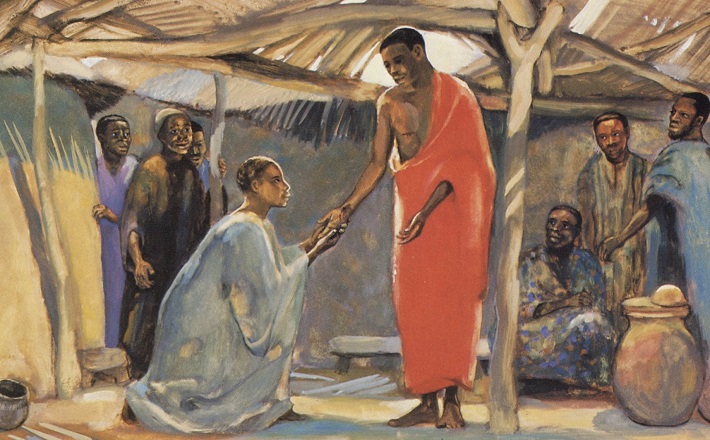Commentary on Acts 2:14a, 22-32
This Sunday presents us with a portion of Peter’s first public sermon, preached on the Day of Pentecost in Jerusalem.
The Holy Spirit has come upon the disciples with power, just as Jesus promised (Acts 1:8). The phenomenon of the disciples proclaiming the works of God in the diverse languages of those gathered — “devout Jews from every nation under heaven” (2:5) — amazes and perplexes everyone and leads to speculation about whether they have had too much to drink (2:13).
Peter addresses the crowd to dispel these rumors and interprets what is happening in light of the promises of Scripture (2:14-16). In verses 17-21, he cites the prophet Joel to show that this is the fulfillment of God’s promise to pour out his Spirit on all flesh in the last days. Starting in verse 22, Peter explains how this phenomenon is inextricably linked to Jesus of Nazareth, “a man attested to you by God with deeds of power, wonders, and signs that God did through him among you.”
God is emphatically in control in Peter’s interpretation of events. This Jesus was “handed over to you according to the definite plan and foreknowledge of God” (2:23). Human beings are certainly culpable for the death of Jesus — both Jews and Gentiles, as Peter says, “you (Israelites) crucified and killed [him] by the hands of those outside the law (Roman Gentiles)” (2:23). But God had a much greater plan for Jesus and raised him from the “pains of death, for it was impossible for him to be held in its power” (2:24; my translation).
The Greek word used to describe the “pains” (ôdinas) of death is normally used to describe birth-pangs. The language of birth-pangs is often associated with the coming of the messianic new age in apocalyptic literature of this period, and we find this language also in Jesus’ apocalyptic discourse in Mark (13:8). The image suggests that the sufferings of the present time will ultimately lead to new life being birthed.
At this point in his message, Peter begins an intricate exegetical argument whose logic may seem obscure to hearers today. Peter cites Psalm 16:9-11 (15:8-11 in the Septuagint), introducing the citation by saying, “For David says concerning him…” Peter assumes that David wrote the Psalms, and that he was also a prophet. Even though David speaks of my soul (“For you will not abandon my soul to Hades, or let your Holy One experience corruption”), he cannot be talking about himself, for as Peter points out, David did see corruption: “he both died and was buried, and his tomb is with us to this day” (2:29). Since David was a prophet, Peter continues, he knew that God had promised to put one of his descendants on his throne, and it is of this descendant, the Messiah, that David speaks in the Psalm.
In referring to God’s promise to put David’s descendant on the throne, Peter alludes to several other Psalm verses — 132:11 and 89:3-4 (131:11 and 88:4-5 in the Septuagint) — as well as Nathan’s oracle to David in 2 Samuel 7:12. Each of these scriptures was interpreted by the early church as referring to the Messiah.
- In 2 Samuel 7:12, God promises to David through Nathan: “I will raise up your seed (sperma) after you, who will be from your body, and I will prepare his kingdom.”
- Psalm 132:11 (131:11 in the Septuagint) refers to this promise in saying: “The Lord swore to David in truth and he will not annul it: ‘Of the fruit of your body I will set a king upon your throne.’” The Psalm elaborates on this promise for several verses and says in verse 17, “I have prepared a lamp for my anointed (christos).”
- Psalm 89:3-4 (88:4-5 in the Septuagint) speaks of this same promise: “You said, ‘I have made a covenant with my chosen one, I have sworn to my servant David: I will establish your seed (sperma) forever, and I will build up your throne for all generations.’”
Peter then returns to Psalm 16, affirming that David foresaw and spoke of the resurrection of the Messiah in saying, “He was not abandoned to Hades, nor did his flesh experience corruption” (Acts 2:31). The fulfillment of this prophecy has now come to pass, for “this Jesus God raised up, and of that all of us are witnesses” (2:32).
Unfortunately, the lectionary text ends at verse 32, but verses 33-36 are necessary to complete the logic of the argument, explaining how the resurrection of Jesus is the catalyst for what is happening on this day. Jesus is not only risen but ascended and exalted at the right hand of God, where he has received the Holy Spirit, which he has in turn poured out upon his disciples (2:33).
Finally, Peter cites Psalm 110:1 (109:1 in the Septuagint): “The Lord says to my lord, ‘Sit at my right hand, until I make your enemies your footstool.’” Again, Peter says that David could not have been talking about himself, since he did not ascend into the heavens (2:34-35). The implication is that David again speaks about the Messiah, who is also referred to as “Lord” (kyrios). Notably, Psalm 16:11 (Lxx: 15:11) ends with “at your right hand are delights forever” (though the citation in Acts 2:28 omits that final phrase). Both Psalms 16 and 110, then, are understood to refer to the Messiah who is at the Lord’s “right hand.”
Finally, Peter concludes his sermon with the bold affirmation: “Therefore let the entire house of Israel know with certainty that God has made him both Lord and Messiah, this Jesus whom you crucified” (2:36).
The response to this sermon of the people in Jerusalem will be explored in next Sunday’s reading. For the preacher, however, it is necessary to reflect on how Peter’s sermon might address the people of God today. What is important for listeners today to hear and understand?
One option is to explore the tension in the text concerning the divine will and human will. The blame for the evil that was done to Jesus is placed squarely on the shoulders of human beings, yet somehow this is understood to have been done according to the plan and foreknowledge of God. How do we make sense of this?
While it is impossible to resolve the tension completely, one thing is clear: God counters the evil, death-dealing ways of humans by emphatically defeating death, snatching new life from the “pains of death, for it was impossible for him to be held in its power” (2:24, my translation). The image of the “birth-pangs (ôdinas) of death” suggests that suffering finally gives way to new life. God’s life-giving power simply cannot be contained by death.
Psalm 16:9 has a lovely turn of phrase in the Greek version that Peter cites (2:26). The Greek (Psalm 15:9 in the Septuagint) says literally, “my flesh will pitch its tent on hope” or “my flesh will nest on hope.” The psalmist then declares the reason for this hope: for God did not allow his Holy One to see corruption, but snatched him from the jaws of death and exalted him to God’s right hand.
Peter declares that the Holy One of whom the Psalm speaks is none other than “this Jesus whom you crucified.” God has exalted him and made him both Lord and Messiah (2:36). Even the worst of human evil cannot derail the life-giving will of God. We are not abandoned to death and destruction. All that Jesus preached and enacted in his ministry is validated and confirmed by his resurrection, ascension, and the pouring out of his Spirit on his followers. God’s life-giving power breaks the bonds of death and continues to be at work in the world through the power of the Spirit. This is the hope on which we pitch our tents, the hope in which we dwell.


April 23, 2017